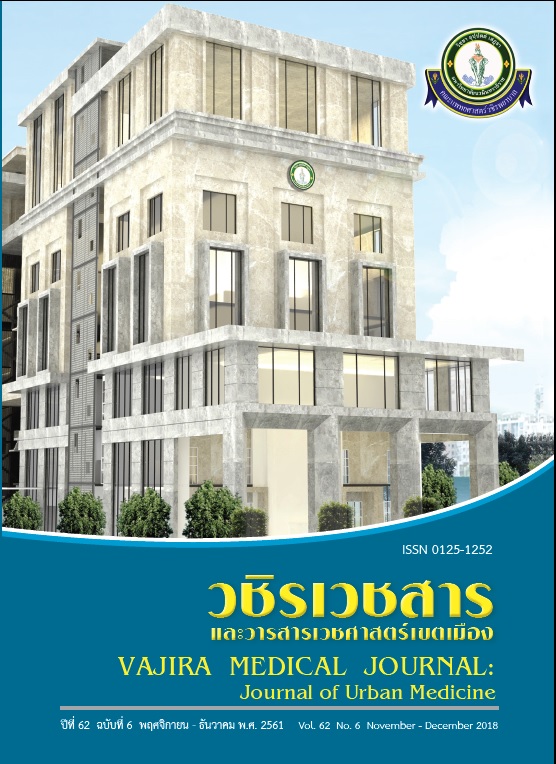Nutritional Screening for Hospitalized Pediatric Patients By STRONGkids Compared with STAMP
Main Article Content
Abstract
Introduction: One third of hospitalized pediatric patients have malnutrition which results in complications and costly medical fee. Therefore, malnutrition screening is important for early detection and prevention of the aforementioned risks.
Objectives: To inspect the prevalence of malnutrition in hospitalized pediatric patients at Vajira Hospital and to identify sensitivity and specificity of STRONGkids and STAMP as screening tools for detection of malnutrition in these patients.
Methods: Cross - sectional study using questionnaire in 405 pediatric patients aged 1 month – 14 years old, who were admitted to pediatric ward at Vajira Hospital from October 2016 – May 2017, was performed. All patients were screened for malnutrition by STRONGkids and STAMP and assessed nutritional status by body weight and length/height.
Results: Of 405 patients, 210 (51.9%) were male. Mean age was 4.5 years old. (Prevalence of malnutrition in this study was 17.3%. There were 49 (12.1%) and 21 (5.2%) case of acute malnutrition and chronic malnutrition, respectively. For screening of malnutrition, STRONGkids had sensitivity, specificity, positive predictive value (PPV), and negative predictive value (NPV) of 95.7%, 22.8%, 20.6%, and 96.2%, respectively. STAMP had sensitivity, specificity, PPV, and NPV of 94.3%, 25.7%, 21%, and 95.6%, respectively, which were not statistically different. However, STRONGkids took less time for screening than STAMP (1.1 minute and 3.2 minutes, respectively).
Conclusion: STRONGkids and STAMP can be used as nutritional screening of hospitalized pediatric patients with height and weight measurement for diagnosis reconfirmation of malnutrition due to low specificity and NPV
Downloads
Article Details
References
2. Joosten KF, Zwart H, Hop WC, Hulst JM. National malnutrition screening days in hospitalized children in The Netherlands. Arch Dis Child. 2010;95:141-5.
3. Dogan Y, Erkan T, Yalvaç S, Altay S, Cokugras FC, Aydin A, et al. Nutritional status of patients hospitalized in pediatric clinic. Turk J Gastroenterol. 2005;16:212-6.
4. Kondrup J, Allison SP, Elia M, Vellas B, Plauth M. Educational and clinical Practice Committee, European Society of Parenteral and Enteral Nutrition (ESPEN). ESPEN guidelines for nutrition screening 2002. Clin Nutr. 2003;22:415-21.
5. Reilly HM, Martineau JK, Moran A, Kennedy H. Moran A, Kennedy H. Nutritional screening, evaluation and implementation of a simple nutrition risk score. Clin Nutr. 1995;14:269-73.
6. Sermet-Gaudelus I, Poisson-Salomon AS, Colomb V, Brusset MC, Mosser F, Berrier F, et al. Simple pediatric nutritional risk score to identify children at risk of malnutrition. Am J Clin Nutr. 2000;72:64-70.
7. Baker JP, Detsky AS, Wesson DE, Wolman SL, Stewart S, Whitewell J, et al. Nutritional assessment: a comparison of clinical judgment and objective measurement. N Engl J Med. 1982;306:969-72
8. Secker DJ, Jeejeebhoy KN. Subjective Global Nutritional Assessment for children. Am J Chin Nutr. 2007;85:1083-9.
9. McCarthy, H., McNulty, H., Dixon, M., Eaton-Evans M.J. Screening for nutrition risk in children: the validation of new tool. J Hum Nutr Diet. 2008;21:395-6.
10. McCarthy H, Dixon M, Crabtree I, Eaton-Evans MJ, McNulty H. The development and evaluation of the Screening Tool for the assessment of Malnutrition in Paediatrics (STAMP®) for use by healthcare staff. J Hum Nutr Diet. 2012;25:311-8.
11. Gerasimidis K, Keane O, Macleod I, Flynn DM, Wright CM. A four-stage evaluation of the Paediatric hospital and a district general hospital. Br J Nutr. 2010;104:751-6.
12. Gerasimidis K, Macleod I, Maclean A, Buchanan E, McGrogan P, Swinbank I, et al. Performance of the novel Paediatric Yorkhill Malnutrition Score (PYMS) in hospital practice. Clin Nutr. 2011;30:430-5.
13. Hulst JM, Zwart H, Hop WC, Joosten KF.Dutch national survey to test the STRONGkids nutritional risk screening tool in hospitalized children. Clin Nutr. 2010;29:106-11.
14. Huysentruyt K, Alliet P, Muyshont L, Rossignol R, Devreker T, Bontems P, et al. The STRONG(kids) nutritional screening tool in hospitalized children: a validation study. Nutrition 2013;29:1356-61.
15. Moeeni V, Walls T, Day AS. Assessment of nutritional status and nutritional risk in hospitalized Iranian children. Acta Paediatr. 2012;101:e446-51.
16. Spagnuolo Ml, Liguoro I, Chiatto F, Mambretti D. Gaurino A. Application of a score system to evaluate the risk of malnutrition in multiple hospital setting. Ital J Pediatr. 2013;39:81.
17. de Onis M, Garza C, Onyango AW, Martorell R. WHO Child Growth Standards. Acta Paediatr. 2006;95 (suppl 450):76-85.
18. คณะทำงานจัดทำเกณฑ์อ้างอิง น้ำหนัก ส่วนสูง และเครื่องชี้วัดภาวะโภชนาการของประชาชนไทย. เกณฑ์อ้างอิง น้ำหนัก ส่วนสูงและเครื่องชี้วัดภาวะโภชนาการของประชาชนไทย อายุ 1 วัน - 19 ปี. นนทบุรี. กองโภชนาการ กรมอนามัย กระทรวงสาธารณสุข. 2542.


